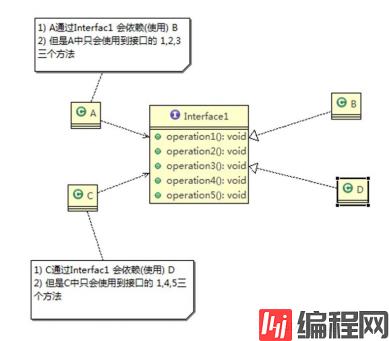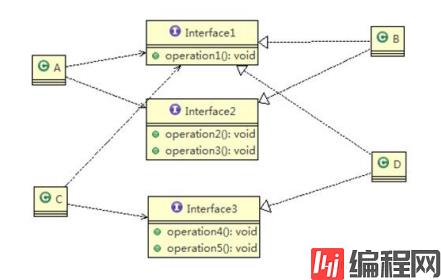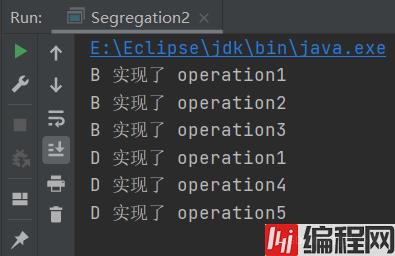Python 官方文档:入门教程 => 点击学习
1.什么是接口隔离原则? 客户端不应该依赖它不需要的接口,即一个类对另一个类的依赖应该建立在最小的接口范围上。 2.对应代码 上面这张图呢,就违反了接口隔离原则。它对应的代码如下:
客户端不应该依赖它不需要的接口,即一个类对另一个类的依赖应该建立在最小的接口范围上。

上面这张图呢,就违反了接口隔离原则。它对应的代码如下:???
package com.szh.principle.segregation;
interface Interface1 {
void operation1();
void operation2();
void operation3();
void operation4();
void operation5();
}
class B implements Interface1 {
public void operation1() {
System.out.println("B 实现了 operation1");
}
public void operation2() {
System.out.println("B 实现了 operation2");
}
public void operation3() {
System.out.println("B 实现了 operation3");
}
public void operation4() {
System.out.println("B 实现了 operation4");
}
public void operation5() {
System.out.println("B 实现了 operation5");
}
}
class D implements Interface1 {
public void operation1() {
System.out.println("D 实现了 operation1");
}
public void operation2() {
System.out.println("D 实现了 operation2");
}
public void operation3() {
System.out.println("D 实现了 operation3");
}
public void operation4() {
System.out.println("D 实现了 operation4");
}
public void operation5() {
System.out.println("D 实现了 operation5");
}
}
class A { //A 类通过接口Interface1 依赖(使用) B类,但是只会用到1,2,3方法
public void depend1(Interface1 i) {
i.operation1();
}
public void depend2(Interface1 i) {
i.operation2();
}
public void depend3(Interface1 i) {
i.operation3();
}
}
class C { //C 类通过接口Interface1 依赖(使用) D类,但是只会用到1,4,5方法
public void depend1(Interface1 i) {
i.operation1();
}
public void depend4(Interface1 i) {
i.operation4();
}
public void depend5(Interface1 i) {
i.operation5();
}
}
public class Segregation1 {
public static void main(String[] args) {
A a = new A();
a.depend1(new B()); // A类通过接口去依赖B类
a.depend2(new B());
a.depend3(new B());
C c = new C();
c.depend1(new D()); // C类通过接口去依赖(使用)D类
c.depend4(new D());
c.depend5(new D());
}
}代码虽然很长,但是不难理解。A类依赖了B类,但是只会用到顶级接口中的1、2、3这三个方法;而C类依赖了D类,但是只会用到顶级接口中的1、4、5这三个方法,也就是说在A和B这两个类的层面上而言,和顶级接口中的4、5两个方法是没什么关联的,那么B类在实现顶级接口的时候就没必要重写4、5这两个方法了。但是这里有一个问题就是顶级接口中包括了1到5这五个方法,你如果实现这个接口就必须重写这五个方法,那么我们就可以考虑将顶级接口拆分成多个接口,需要用到哪个就实现哪个,这也就是所谓的接口隔离了。

经过上面的一番叙述,我们可以将代码改写成下面的形式。
即将顶级接口拆分成3个小接口,B、D两个类根据实际情况该实现哪个接口就实现哪个接口(因为这五个方法已经被分开了)。
package com.szh.principle.segregation.improve;
interface Interface1 {
void operation1();
}
interface Interface2 {
void operation2();
void operation3();
}
interface Interface3 {
void operation4();
void operation5();
}
class B implements Interface1, Interface2 {
public void operation1() {
System.out.println("B 实现了 operation1");
}
public void operation2() {
System.out.println("B 实现了 operation2");
}
public void operation3() {
System.out.println("B 实现了 operation3");
}
}
class D implements Interface1, Interface3 {
public void operation1() {
System.out.println("D 实现了 operation1");
}
public void operation4() {
System.out.println("D 实现了 operation4");
}
public void operation5() {
System.out.println("D 实现了 operation5");
}
}
class A { // A 类通过接口Interface1,Interface2 依赖(使用) B类,但是只会用到1,2,3方法
public void depend1(Interface1 i) {
i.operation1();
}
public void depend2(Interface2 i) {
i.operation2();
}
public void depend3(Interface2 i) {
i.operation3();
}
}
class C { // C 类通过接口Interface1,Interface3 依赖(使用) D类,但是只会用到1,4,5方法
public void depend1(Interface1 i) {
i.operation1();
}
public void depend4(Interface3 i) {
i.operation4();
}
public void depend5(Interface3 i) {
i.operation5();
}
}
public class Segregation2 {
public static void main(String[] args) {
A a = new A();
a.depend1(new B()); // A类通过接口去依赖B类
a.depend2(new B());
a.depend3(new B());
C c = new C();
c.depend1(new D()); // C类通过接口去依赖(使用)D类
c.depend4(new D());
c.depend5(new D());
}
}
到此这篇关于Java设计模式之接口隔离原则精解的文章就介绍到这了,更多相关Java 接口隔离原则内容请搜索编程网以前的文章或继续浏览下面的相关文章希望大家以后多多支持编程网!
--结束END--
本文标题: Java设计模式之接口隔离原则精解
本文链接: https://lsjlt.com/news/138419.html(转载时请注明来源链接)
有问题或投稿请发送至: 邮箱/279061341@qq.com QQ/279061341
2024-03-01
2024-03-01
2024-03-01
2024-02-29
2024-02-29
2024-02-29
2024-02-29
2024-02-29
2024-02-29
2024-02-29
回答
回答
回答
回答
回答
回答
回答
回答
回答
回答
0